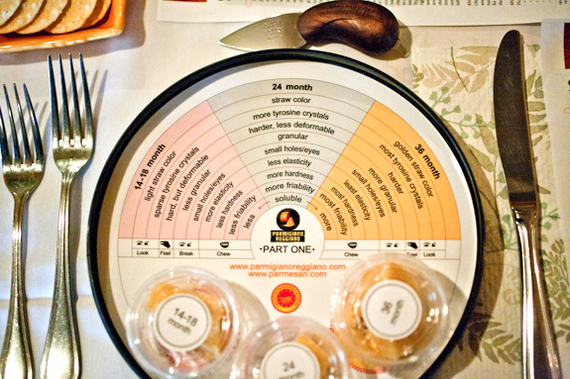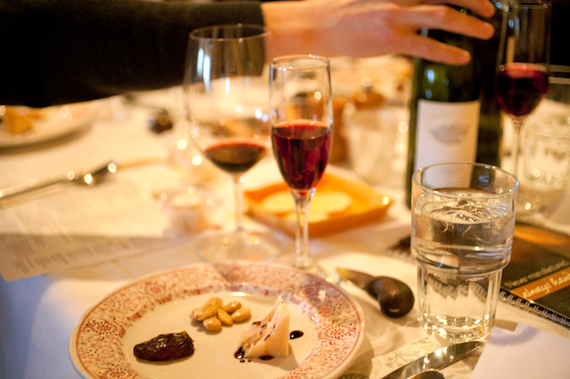Co-authored with Lee Glenn
South Carolina, Nevada, Parmigiano-Reggiano... must have more than one thing in common, but for today Chef Natalie Sellers of 4th Street Bistro in Reno makes the connection. I met Natalie at the recent Chef's Collaborative Summit in Charleston. The Parmesan part, courtesy of her specialty cheese purveyor, Wedge, together they're committed to a food education program as promoted by the Chef's Collaborative.
Lee and I are in Natalie's restaurant, snuggled in a 1930s bungalow, hiding from the roadway behind a curtain of vibrant yellow reeds on the edge of downtown. Awareness of finer, fresher foods is coming to Natalie's customers through a vertical tasting of specialty parmesan Parmigiano-Reggiano, accompanied by a four-course meal featuring local sustainable farm fare and wine pairings. Wedge owners Laura Conrow and Peter Burge are walking the diners through the nuances of parmesan making, aging and tasting.
Natalie and partner Carol Ann Wilson have owned 4th Street Bistro for 13 years. Laura and Peter are relative newcomers, opening Wedge 15 months ago after recognizing a growing market for specialty cheeses in the Reno area and sharing a passion for cheese informed by professional level courses at the Cheese School of San Francisco. Their joint business, Wedge, now has a regular program of cheese education that includes cheese basics, cheese and beer pairings and creating holiday cheese platters.
"The challenge is making people aware, identifying the value of specialty cheeses," says Peter.
We can't help but wonder why parmesan and specifically, Parmigiano-Reggiano. In addition to being one of Natalie's favorite cheeses for preparing scrumptious dishes, there is only one northern Italian region allowed to make Parmigiano-Reggiano, a handmade artisan cheese created through ancient methods and locavore values going back to the 13th century. Laura explains, "The secrets of its goodness originate in its place of origin, in natural feed and high quality milk with no additives. This gives the cheese its unique flavor and texture."
P-R cows are fed strictly controlled diets based on local grasses and natural vegetable feed. They eat no silage, no fermented foods, no food of animal origin nor food that is a by-product of the food industry. The resulting pure milk forms the starting point. A natural whey starter obtained from the previous day's cheese making and natural rennet, an enzyme from the stomach of suckling calves, begins the cheese making. This process has been handed down from generation to generation.
As per author Nancy Radke, the final ingredient is time: "What makes Parmigiano-Reggiano so outstanding is its long careful aging. Each wheel is aged an average of 24 months."
Apparently it takes 150 gallons of this pure milk to produce one 80-pound wheel. In a world of mass-produced sameness, this cheese is made by hand, usually only eight or twelve wheels at a time.
An appreciation for aging and the distinct qualities it conveys is the key to tonight's tasting. Laura and Steve provide each guest with three samples, 14 -18 month, 24-month and the unusual 36-month aged parmesan. Accompanying the samples is a clever tasting wheel delineating the distinctions including taste, texture, friability, hardness and solubility. Playfully framed in a Frisbee, its playful design lessens the intimidation factor of learning characteristic profiles.
It is fascinating to taste test how the changes of character in the cheese are influenced by time. This sensory analysis includes sight, texture, aroma and taste. P-R in particular, is valued for its complex aromas and flavors.
The color, eyes (holes) and tyrosine crystals vary amongst the samples. Tyrosine is related to morphine... no wonder we love this cheese. The texture is smooth to rough, soft to hard, sticky to slippery. Breaking each piece between our fingers, we evaluate:
Hard like a carrot?
Elastic like a hot dog?
Friable like a cracker?
Humid like a hard-boiled egg?
Next we close our eyes, break a piece and inhale deeply. This is the most important analysis. Are the aromas pineapple? Walnut? Hummus? Wet grass? Cloves? Leather? It can be any of those things based on age and cheese terroir.
Unique taste based on locale, aging, technique, farming culture and even a measure of seasonal inconsistency, is a hallmark of the P-R process. As Laura notes: "Industrially produced cheeses blend milks from around the country for homogeneity. With artisan cheeses, the milk changes with what the cows are eating and that changes seasonally. When you crack a parmesan wheel, the beauty of the natural structure cleavage is like poetry."
 Natalie's tasting menu expresses the aged flavors of the cheese through the freshest produce from farmer neighbors. The youngest cheese is shaved a top Urban Roots local greens and a sherry vinaigrette. The 24-month makes for a great frico atop Melwaldts's Organics sunchoke & potato soup. Avanzino Farms butternut squash is roasted for a risotto with more grated 24-monther. The 36-month is served as chunks for desert with Medjool dates, Marcona almonds and fig balsami. Natalie wishes you to enjoy these recipes!
Natalie's tasting menu expresses the aged flavors of the cheese through the freshest produce from farmer neighbors. The youngest cheese is shaved a top Urban Roots local greens and a sherry vinaigrette. The 24-month makes for a great frico atop Melwaldts's Organics sunchoke & potato soup. Avanzino Farms butternut squash is roasted for a risotto with more grated 24-monther. The 36-month is served as chunks for desert with Medjool dates, Marcona almonds and fig balsami. Natalie wishes you to enjoy these recipes!
As we are discovering across the country, education is a vital part of the Chefs Collaborative mission as supported by the FoodShed Exchange -- education in seasonality, diversity, sustainably raised foods and peak-of-season harvest. Together 4th Street Bistro and Wedge are doing their part to bring appreciation and understanding to the west, elevating the food culture of Reno.
Images are author's own.




